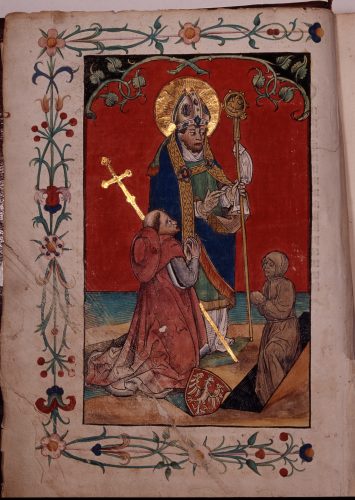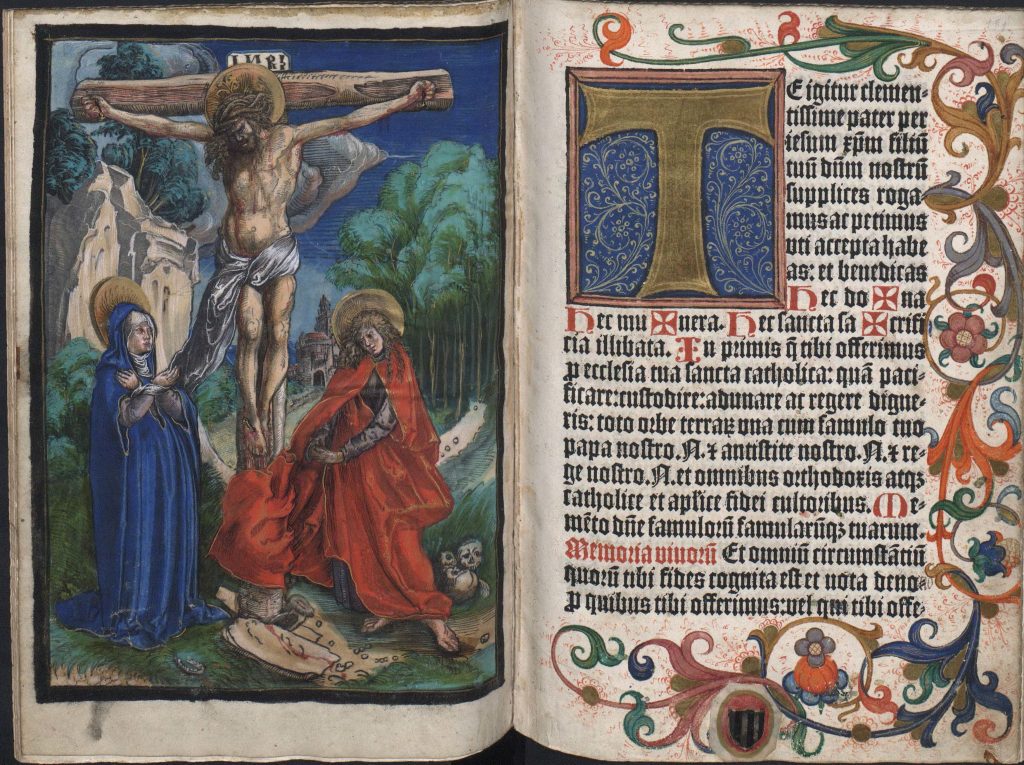The relationship between miniature and print in the early sixteenth-century liturgical book was very close. During the Middle Ages liturgical books were copied manually. This resulted in changes, errors, omissions, which caused serious differences between them and, therefore, in the rites of the liturgy. Since the half of the fifteenth century the attempts to minimise this incoherence of texts were made by the popes, but the process lasted long and was difficult to control. In 1453 Pope Nicholas V demanded that within a year all parishes should have corrected their missals according to the cathedral missals. Nevertheless, it was still unsuccessful until the printing method enabled such demands to be more realistic.
At that time liturgical books started to be standardised, at least within the dioceses. Bishops ordered the same printed liturgical books and made the parishes buy them. In such a way they tried to unify the liturgy. Catholic Church’s councils and synods demanded to buy and use only confirmed texts. The fact that each diocese was supposed to use only the missals or breviaries prepared especially for them, increased the demand for the printed book and contributed to the development of printing in the Polish lands.
Cracow was one of the first Polish centres where such a reform began. At the turn of the fifteenth and sixteenth centuries the main entrepreneur in Cracow was Johannes Haller. He used his connections with the clergy and secured himself by getting the privilege from Fryderyk Jagiellończyk, the bishop of Cracow and the archbishop of Gniezno for printing the liturgical books. Such privileges were given by the clergy or rulers in order to secure the rights of the publisher and prevent others from printing the same book.
An exclusive right gained by Haller to print the two variants of Missale Cracoviense, was one of the first privileges for printers at all (Juda 1992: 33-34). Before each new edition Haller renewed the privilege and, therefore, he was assured of getting a lot of commissions and a stable income. In order to publish these missals for the Cracovian diocese, Haller started to cooperate with Georg Stuchs, a minor printer from Nuremberg. These two examples were one of the first missals commissioned by Haller (Kawecka-Gryczowa 1983: 45-47). Furthermore, they were printed abroad before he started his own publishing house in Cracow.
The first one, the copy of which is preserved in the Jagiellonian Library in Cracow (shelf-mark Inc. 2861), was printed probably just after granting the privilege, ca. 1494. Pages of the missal were decorated both with miniatures and hand-coloured woodcuts. These prints were initials and two whole-page figurative scenes: Saint Stanisław Resurrecting Piotrowin accompanied by Fryderyk Jagiellończyk (fig.1) on the title page and Crucifixion (fig.2) on the page preceding the Canon Missae. Canon was the most important part of the book, often printed on parchment whereas the rest was printed on paper. According to tradition, which goes back to the handwritten missals, it started with the representation of the Crucifixion. The woodcut from this copy of Missale Cracoviense was coloured manually with water-based pigments in a typical, limited palette: blue, green, yellow and red (Primeau 2013: 3). The most intensive spots of colour were the Virgin’s and Saint John’s clothes. Also, the angel’s dress and wings were painted with intensive dark green while the parts of the wings of all angels were painted dark blue, green and orange. The colouring is very precise and only very few places are left without any hue, the most visible one being the Apostle’s feet. It seems that even the use of green in the crown of thorns was thought to fit the other elements well.


It is significant that the image of the crucified Christ was very often one of the biggest colourful elements in the whole book. As Primeau suggested “the addition of colour made the images more eye-catching, naturalistic and legible” (Primeau: 2). It seems that the function of colour was to catch the eye of the user and make them stop and contemplate the image of suffering Christ. Such interpretation can be confirmed by the statement that “hues have conveyed meanings that brought the viewer into a closer connection with the divine” (ibid.: 2).
An important and typical feature was the Saviour’s blood which flowed on his head and neck, on arms and hands as well as on the stomach, legs and feet. The presence of blood was an inherent element of coloured scenes of Crucifixion. As the “good” type of red it symbolised the purification and redemption (Adamska 2015: 13; Dackermann 2002: 29-30). The well-considered colouring was emphasised even more by the golden background and halos around the figures’ heads. It is worth noticing that the black frame, typical for the woodcuts, was coloured in an alternate way, in green and red. Again, it seems to be a well-thought idea which fulfils the whole work of art.
The margins of the woodcut were surrounded with an elegant, floral frame composed of flowers. The use of gold and the double frame, the tiny one and a very decorative floral frame on the margins made this composition elegant and precious. One can assume that such form was thought to catch the viewer’s eye and let him admire and contemplate the scene. This elegant way of colouring, distinguished by the golden background, makes the woodcut look more as a miniature than a print. Although the style of the illuminations is already different from earlier ornaments, the way of colouring the woodcuts indicates that it still represented the medieval way of thinking.
Another example of such imitation is the second edition of Missale Cracoviense, which was smaller and destined to be used during travelling. Its copy is also held in the Jagiellonian Library in Cracow (shelf-mark Inc. 2850). This liturgical book was commissioned by Haller and printed by Stuchs in Nuremberg between 1493 and 1500. In this case the scene on the title page (Saint Stanisław Resurrecting Piotrowin accompanied by Fryderyk Jagiellończyk) is uncoloured, only the halo of the saint was painted in gold. Sixteen pages were decorated with hand-coloured woodcut initials and floral illuminations on the margins.
An interesting addition was the woodcut by Lucas Cranach the Elder depicting Crucifixion (fig. 3) which was subsequently pasted on a page before the Canon Missae. It was impressed on parchment and painted very thoroughly with opaque paints (Jurkowlaniec, Herman 2021: 3-4). The scene is much more extended in comparison to the Crucifixion of the ca. 1494 edition of Missale (cf. fig. 2). The figures are not so stiff while the landscape background is full of details. The two prints represent different attitudes of composing space and human figure. Both examples are very precious and elegant, the colour is intensive in each case. However, the shiny golden print stands in contrast with the opaque paints of Cranach’s work. This print is really exceptional because of the subtlety and diversification of colours as well as the lights marked with the white paint. Gold was used here in the halos and as a tiny addition to the saints’ clothes.

All in all, the two editions of Missale Cracoviense are good examples of the infiltration between miniature and print. The manner of painting woodcuts almost thoroughly so that the lines were hardly visible as well as the use of gold and decorative floral motives on margins confirm the thesis that these colourful elements imitated the decoration of illuminated manuscripts. Moreover, it proves a high demand that the liturgical books should still resemble the well-known medieval form.
Quoted literature:
Adamska, Anna, 2015. “Gra w kolory. Rola barw w średniowiecznym systemie komunikacji społecznej” [Playing with colours: the role of colours in the medieval system of social communication]. Roczniki Historyczne 81: pp. 7-34.
Dackermann, Susan, 2002. Painted Prints: The Revelation of Color in Northern Renaissance & Baroque Engravings, Etchings & Woodcuts. Baltimore: Baltimore Museum of Art; University Park: Pennsylvania University Press.
Juda, Maria, 1992. Przywileje drukarskie w Polsce [The privileges of printers in Poland], Lublin: Agencja Wydawniczo-Handlowa AD.
Jurkowlaniec, Grażyna, Herman, Magdalena, 2021. “Introduction”. In The Reception of the Printed Image in the Fifteenth and Sixteenth Centuries: Multiplied and Modified, edited by Grażyna Jurkowlaniec and Magdalena Herman, pp. 1-23. New York: Routledge.
Kawecka-Gryczowa, Alodia, 1983. “Haller Jan.” In: Drukarze dawnej Polski, pp. 44-62.
Primeau, Thomas, 2013. “Coloring Within the Lines: The Use of Stencil in Early Woodcuts,” Art in Print”, 3/ 3. Available online: https://artinprint.org/article/coloring-within-the-lines-the-use-of-stencil-in-early-woodcuts/ (accessed: 20.11.2020)